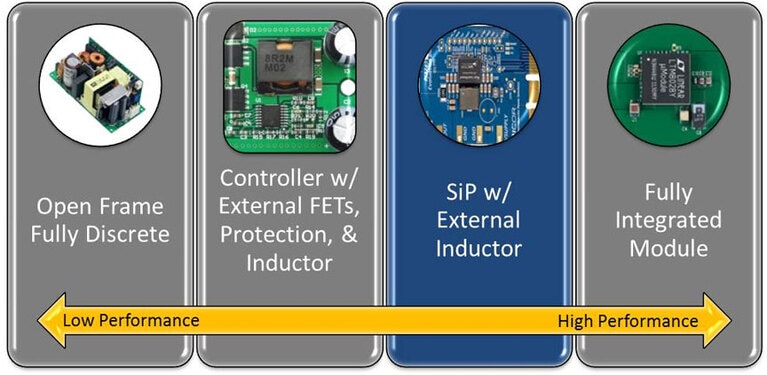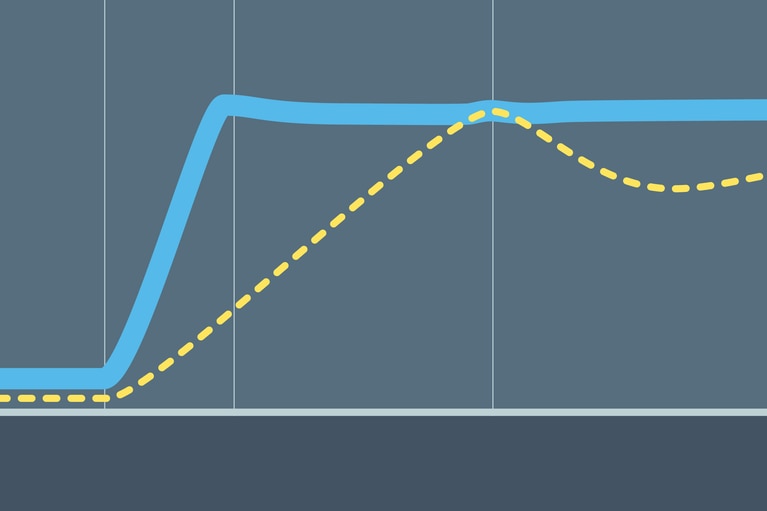
ReVolt – 技術問答
ReVolt 正在解决好莱坞片場的排放問題,下一步將把可擕式 DC 電源應用於建築工地、應急回應事件等領域
尊敬的用戶:
為了改進 Vicor 網站,我們將於美國東部時間 12 月 29 日上午 11:30 至下午 2:00 對網站進行維護。
在此期間,您可能無法查看網站的某些部分,特別是產品頁面和產品型號清單。
對於給您帶來的不便,我們深表歉意,並感謝您的耐心等待。
– Vicor 網站團隊
Switching regulator solutions are offered in various levels of integration, offering a broad spectrum of performance, features, and packaging. They range from open frame discrete solutions to fully integrated modules.
Figure 1. Different levels of Integration in Regulator Solutions
There are numerous tradeoffs to each type of design, but the one that takes the lead in performance vs. cost for the 50W to 100W-type point-of-load design is the SiP-type regulator, especially when combined with a ZVS switching topology. These SiP-based regulators, like our Vicor ZVS regulators, are built on an over-molded substrate, which integrates power FETs, passive components, and predefined compensation components. This packaging approach integrates the majority of the regulator system except for the inductor and input/output capacitors.
With an external inductor, board-level heat dissipation is superior vs. the module approach where heat is concentrated in one location (the inductor can generate 40-50% of the total regulator heat). Without being constrained by package profile limitations external inductor design can be optimized for efficiency. Lower switching losses of the Vicor ZVS topology translate into higher efficiency, lower heat dissipation, and higher density. On the cost side, competitive modules from various IC vendors, including Vicor, typically hold a 1.5x to 3x premium over SiP-based regulators.
Considering that module performance lags vs. SiPs, and they cost more, designers might ask if the modules’ small gains in density are really worth it. At least for the Vicor-based SiP regulators, our density (power delivery vs. x-y board area consumption) is on par with modules, even when including all the required components (the external inductor and input/output capacitors). This is because the modules also require external input/output capacitance. Vicor’s ZVS topology supports high frequency operation (without sacrificing efficiency) and this allows for smaller passives.
Applications vary and hence there is a need for various levels of regulator integration, however, when looking at efficiency, size, and cost, our ZVS regulators set a performance/cost metric that surpasses that of many fully integrated modules. This can be counter intuitive to many designers especially when not aware of the added benefits of a ZVS switching topology regulator.
Related content
Product overview: ZVS buck switching regulators
ReVolt – 技術問答
ReVolt 正在解决好莱坞片場的排放問題,下一步將把可擕式 DC 電源應用於建築工地、應急回應事件等領域
雙向供電與快速瞬態回應能力賦能可擴充的主動懸架系統
正弦振幅轉換器™ (SAC™) 模組憑藉其獨特的雙向供電功能與瞬態回應速度組合,為主動懸架系統開闢了全新可能性
提供更高的峰值功率和更快的動態瞬態回應,實現更輕、更强大的電動汽車架構
隨著時間的推移,市場上的電動汽車(EV)對電驅動系統的依賴程度日益加深,例如線控轉向、線控制動以及主動懸架系統等
電流倍增器:為 AI 處理器及其他嚴苛應用供電的明智之選
AI 處理器需要解决低電壓、高電流的嚴苛挑戰,這將會導致電源系統設計產生瓶頸。瞭解 Vicor 的電流倍增技術如何改變這一現狀



